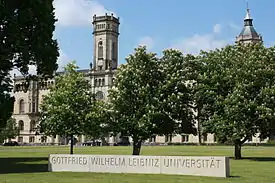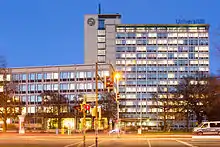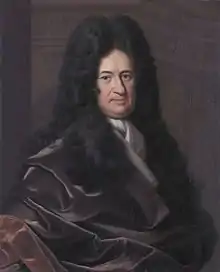University of Hanover
The Leibniz University Hannover,[8] long form in German Gottfried Wilhelm Leibniz Universität Hannover, is a public research university located in Hanover, Germany. Founded on 2 May 1831, it is one of the largest and oldest science and technology universities in Germany.[9] In the 2014/15 school year it enrolled 25,688 students, of which 2,121 were from foreign countries. It has nine faculties which offer 190 full and part degree programs in 38 fields of study.[10] It was named University of Hannover in 1978. In 2006, it was named after Gottfried Wilhelm Leibniz, the 18th century mathematician and philosopher. In 2018, Leibniz University Hannover was adopted as the official English name.[8]
Gottfried Wilhelm Leibniz Universität Hannover | |
 | |
Former names | |
|---|---|
| Motto | Mit Wissen Zukunft gestalten[4] |
Motto in English | Shaping the future with knowledge |
| Type | Public |
| Established | May 2, 1831[1] |
| Budget | € 447.2 million[5] |
| President | Volker Epping |
Academic staff | 3,046[6] |
Administrative staff | 1,739[6] |
| Students | 26,035[7] |
| Location | , , Germany |
| Affiliations | TU9 TIME CESAER Association |
| Website | www.uni-hannover.de |

Leibniz University Hannover is a member of TU9, an association of the nine leading Institutes of Technology in Germany. It is also a member of the Conference of European Schools for Advanced Engineering Education and Research (CESAER), a non-profit association of leading engineering universities in Europe. The university sponsors the German National Library of Science and Technology (TIB), the largest science and technology library in the world.[11]
History
.jpg.webp)
The roots of the University begin in the Higher Vocational College/Polytechnic Institute (German: Höhere Gewerbeschule/Polytechnische Schule), founded on 2 May 1831.[1] In 1879 the Higher Vocational School moved into the historic Guelph Palace, the Welfenschloss, which was specially converted for the purpose. On 1 April 1879, the Higher Vocational School became the Royal College of Technology (German: Königliche Technische Hochschule).[2] In 1899 Kaiser Wilhelm II granted the College of Technology a status equal to that of universities and the right to confer doctorates. The College was reconstructed in 1921 with the financial support of the College Patrons’ Association. As of 1 July 1922, there were three faculties: Mathematics and Natural Sciences, Civil Engineering, Mechanical Engineering.[1] In 1968 the Faculty of Humanities and Political Science were founded and the "Technische Hochschule" ("Technical College" or "Technical University") became the "Technische Universität Hannover" ("Technical University Hannover"). Between 1973 and 1980 the faculties of Law, Business and Economics, and the formerly independent Teachers Training College were added to the University and in 1978 the "Technische Universität Hannover" was renamed "Universität Hannover" ("University of Hannover"). Student numbers exceeded 30,000 for the first time in 1991. On the 175th anniversary of the institution in 2006, the "University of Hannover" was given the name "Gottfried Wilhelm Leibniz Universität Hannover", or "Leibniz Universität Hannover" for short. The University adopted an official English name, "Leibniz University Hannover", in 2018.[8] While 64 students first attended the Vocational School, today the university has around 25.700 students, more than 2.900 academics and scientists, and 160 departments and institutes.[12]
Namesake
The Senate of the University voted in April 2006 to rename the University of Hannover to "Leibniz Universität Hannover". Following agreement by the Leibniz Academy on the use of the name, the "Gottfried Wilhelm Leibniz Universität Hannover" received its name on the 360th anniversary of Gottfried Wilhelm Leibniz's birth. The brand of the university is "Leibniz Universität Hannover".
The old logo of the University was inspired by the Massachusetts Institute of Technology. The current logo, adopted in 2008, is a stylised excerpt from a letter to Duke Rudolf August of Wolfenbüttel, in which Leibniz presented binary numbers for the first time.[13]
Faculties and staff
Nine faculties with more than 190 first-degree full-time and part-time degree courses make the university the second-largest institution of higher education in Lower Saxony. The university staff comprises 2930 research and teaching staff, of whom 321 are professors. It has 1810 additional employees in administrative functions, 90 apprentices and some 1400 staff funded by third parties.[12]
- Faculty of Architecture and Landscape Sciences
- Faculty of Civil Engineering and Geodetic Science
- Faculty of Economics and Management
- Faculty of Electrical Engineering and Computer Science
- Faculty of Humanities
- Faculty of Law
- Faculty of Mathematics and Physics
- Faculty of Mechanical Engineering
- Faculty of Natural Sciences
- QUEST Leibniz Research School
- Leibniz School of Education[14]
Facilities

The campus of the university is spread over 160 buildings occupying 322,700 m2 of floor space.[12]
Budget
The University's overall budget was approximately 441.8 million euros in 2013, broken down as follows:[12]
- Income of 222.6 million according to the annual report
- External funding amounting to 101.8 million euros
- Special funds from the State of Lower Saxony amounting to 58.3 million euros
- 42.3 million euros from other income
- 16.8 million euros from student contributions
Rankings
| University rankings | |
|---|---|
| Global – Overall | |
| ARWU World[15] | 601–700 (2020) |
| QS World[16] | 651–700 (2021) |
| THE World[17] | 501–600 (2021) |
Measured by the number of top managers in the German economy, Leibniz University Hannover ranked 7th in 2019.[18]
The Times Higher Education World University Rankings 2020 ranked Leibniz University Hannover between 301-400 worldwide in the fields of engineering & technology, computer science, and physical sciences.
University library and TIB

The library was established on the founding of the Höhere Gewerbeschule/Polytechnische Schule in 1831. It expanded into an important collection as the institution evolved from a vocational/technical college into the full University. The removal of the books into storage during the Second World War secured valuable old stocks that became a unique national collection of scientific and technical literature in postwar Germany. This was the basis on which the library of the Institute of Technology (German: Technische Informationsbibliothek) was established in 1959. Today the collection forms the heart of the German National Library of Science and Technology, which is the largest institution of its kind in the world.[11]
GISMA School of Business
GISMA Business School in Hannover, Germany, was launched in 1999 as a joint initiative by the state of Lower Saxony and visionary private-sector enterprises. The school was closely affiliated with the Krannert School of Management at Purdue University (Indiana, USA) until 2011 when the Leibniz University Hannover briefly became its parent. In 2013 the association with Leibniz ended, and GISMA became part the for-profit education company Global University Systems.
Notable people
Faculty
- Friedrich Bergius (1884–1949), chemist, Nobel Prize in chemistry (1931)
- Constantin Carathéodory (1873–1950), mathematician, professor
- Horst Dreier (born 1954), lawyer
- Gerhard Ertl (born 1936), physicist and chemist, Nobel Prize in chemistry (2007)
- J. Hans D. Jensen (1907–1973), German physicist, Nobel Prize in physics (1963)
- Wilhelm Jordan, (1842–1899), professor of geodesy and practical geometry, known for the Gauss-Jordan Elimination
- Karl Karmarsch (1803–1879), engineer, educationalist
- Theodor Lessing (1872–1933), philosopher
- Oskar Negt (born 1934), social philosopher
- Eduard Pestel (1914–1988), engineer and politician
- Ludwig Prandtl (1875–1953), physicist and engineer in fluid- and aerodynamics, professor.
- Friedrich Schwerd (1872–1953), professor for machinery and operations research, inventor of the WW I. German army Stahlhelm
- Fritz Sennheiser, (1912–2010), electronics engineer, entrepreneur: Honorary professorship.
- Klaus Töpfer (born 1938), German politician (Christian Democratic Union)
Alumni
- Carl F. W. Borgward (1890–1963), entrepreneur, car manufacturer, engineer, guest auditor.[19]
- Walter Bruch (1908–1990), electronics and television engineer, honorary doctorate.
- Alfred Bucherer (1863–1927), physicist
- Wilhelm Busch (1832–1908), poet and artist
- Luise Druke (born 1948), German scholar and United Nations practitioner
- Irmgard Flügge-Lotz (1903-1974), German-American mathematician and engineer
- Henrich Focke (1890–1979), German aviation pioneer
- Erich Gutenberg (1897–1984), German economist.
- Rento Hofstede Crull (1863–1938), electrical pioneer
- Pascual Jordan (1902 – 1980), theoretical and mathematical physicist, politician (CDU)
- Wolfgang Jüttner (born 1948), German politician (SPD)
- David McAllister (born 1971), German politician (CDU)
- Christian Otto Mohr (1835–1918), civil and structural engineer
- Carl Adam Petri (1926–2010), mathematician, logician and computer scientist
- Frank Pohlmann (born 1959), American politician and businessman
Panorama
 Leibniz University Hannover (main building). On the right the International Office: a facility to contact for advice and guidance connected with international matters |
See also
Notes
References
- "Geschichte, Gebäude und Personen" (PDF). Leibniz University Hannover. Retrieved 12 December 2018.
- "Auf dem Weg zur Technischen Hochschule". Auf dem Weg zur Technischen Hochschule. Retrieved 13 December 2018.
- "Key Events in the History of the University". Leibniz Universität Hannover. Retrieved 12 December 2018.
- uni-hannover.de: Leitbild der Gottfried Wilhelm Leibniz Universität Hannover Archived 26 November 2011 at the Wayback Machine. Stand: 1. Februar 2012
- "Zahlenspiegel 2016" (PDF). Leibniz University Hannover (in German). p. 57. Archived from the original (PDF) on 27 September 2017. Retrieved 10 June 2017.
- "Zahlenspiegel 2016" (PDF). Leibniz University Hannover (in German). pp. 46–48. Archived from the original (PDF) on 27 September 2017. Retrieved 10 June 2017.
- "Studierendenstatistik SS 2017" (PDF). Leibniz University Hannover (in German). Archived from the original (PDF) on 27 September 2017. Retrieved 10 June 2017.
- "Informationen für die Leibniz Universität Hannover, Ausgabe Juni 2018" (PDF). uni-hannover.de. Leibniz University Hannover. Retrieved 5 November 2019.
Gleichzeitig gibt es mit „Leibniz University Hannover“ nun auch eine offizielle Übersetzung für die Kurzform des Universitätsnamens. Weitere Einzelheiten regelt das Rundschreiben 22/2018
- uni-hannover.de: Studium, Stand: 15. April 2009
- Studierendenzahlen für das Wintersemester 2014/15 Archived 18 December 2014 at the Wayback Machine. Retrieved, December 2014
- Profile of the TIB at Leibniz University Hannover online Archived 23 April 2012 at the Wayback Machine (English) retrieved 26 May 2012
- uni-hannover.de: Die Leibniz Universität Hannover in Stichworten Archived 5 August 2016 at the Wayback Machine; retrieved, 18 December 2014
- uni-hannover.de. "Neues Corporate Design der Leibniz Universität Hannover entsteht". Archived from the original on 3 April 2008. Retrieved 27 March 2008.
- Leibniz University Hannover. "Leibniz University Hannover Faculties". Leibniz University Hannover. Retrieved 27 April 2020.
- "ARWU World University Rankings 2020 - Academic Ranking of World Universities 2020 - Top 500 universities - Shanghai Ranking - 2020". www.shanghairanking.com.
- "QS World University Rankings". topuniversities.com.
- "The World University Rankings: Leibniz University Hannover". Times Higher Education (THE).
- "An diesen Unis haben die DAX-Vorstände studiert | charly.education". www.charly.education (in German). Retrieved 19 October 2019.
- http://www.spiegel.de/spiegel/print/d-43067968.html "Der Bastler", Der Spiegel 51/1960
External links
| Wikimedia Commons has media related to Universität Hannover. |
- Leibniz University Hannover—Official website (English version)
- Leibniz Alliance Hannover (LEAH)
